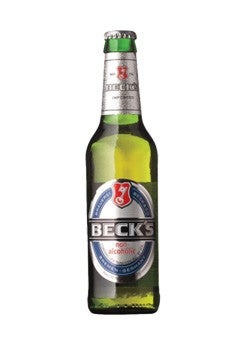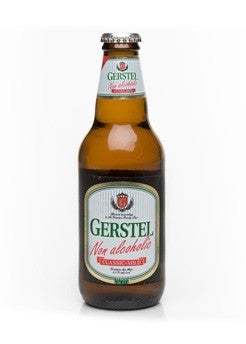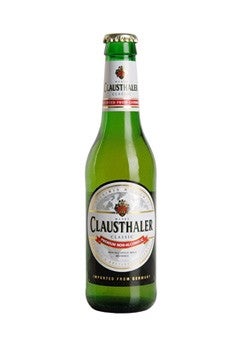I used to be as dismissive of nonalcoholic beer as I was of decaf coffee: What’s the point? I’d wonder, while having numerous real beers instead.
The point, of course, became much more clear a couple of years ago when, for a variety of reasons, I got sober.
Now, I drink near beer daily.
But first things first: I understand near-beer is typically frowned upon by people in recovery — and for good reason. The term “nonalcoholic beer” is a misnomer: These beverages contain small amounts of alcohol — up to 0.5 percent by volume in the U.S. Granted, this means you would need to chug nearly 10 of them to equal just one standard beer, but people following a strict sobriety program consider using mouthwash containing alcohol to be a relapse. (Original formula Listerine is about 54 proof with 26.9 percent alcohol, compared to beer, which is typically 3 to 7 percent alcohol; experts, in fact, claim it’s probable that swishing with certain types of mouthwash can trigger a positive breathalyzer test for 7 to 20 minutes after use.)
Recovery experts recommend substituting healthy activities for behaviors from the past, not sitting around drinking near-beer (or non-beer, as George W. Bush refers to it) with the same people in the same places you abused the real thing with.
That said, I haven’t allowed any of the above to stop me from participating in this relatively benign vice. I weigh 230 pounds, and back in my heavy drinking days, I typically required two six-packs of Coors Light to feel a buzz — or the equivalent of 114 near-bears. Even retired baseball legend Wade Boggs could only drink 107 Miller Lights on a cross-country road trip, so I’m pretty confident nonalcoholic beer won’t throw me off the wagon any time soon.
Plus, I love it.
And more to the point, it’s that time of year.
Few things are as satisfying as cracking a cold one on a hot summer afternoon, whether it’s complementing a barbecue, a Wiffle ball game or a shower. And the first sip of an nonalcoholic beer tastes exactly the same as its boozy counterpart — or at least my brain can’t tell the difference. Better yet, I can pound them like an SAE pledge — all day and all night — and still be the designated driver. (That said, it is illegal to drive while drinking a nonalcoholic beer, as Washington State Patrol Trooper Dan McDonald told the Seattle Post-Intelligencer in 2009: “If there is any alcohol in it, then that is a violation. But I think the officer’s discretion would come into hand. Everything is situational.”)
I’m not alone in my affinity for fake beer either: VICE called it “cool” a couple years ago; The Huffington Post asked if it could “save big brewers” in 2015; and The Economist noted in 2013 that sales of non-alcoholic beer were booming. More than 2 billion liters were drunk in 2012 — or 80 percent more than five years earlier — making near-beer one of the “fastest-growing segments in an otherwise static or declining beer market,” according to Sean Durkan of Bavaria beer, an independent brewery selling 0 percent ABV beer along with lighter alcoholic beers. That probably helps explain why nonalcoholic beers are roughly the same price as their more mature brothers, with six-packs typically ranging from $7–10.
My current favorites include:

Beck’s is my go-to. It’s light and crisp; plus, along with O’Doul’s, it’s always available at Southern California liquor stores. The teenager in me won’t allow myself to arrive at a party with a six-pack of O’Doul’s — easily the un-coolest high school beverage — though the amber variety does make for a nice alternative every now and again.
A co-worker hipped me to Buckler, brewed by Heineken. It tastes like a generic light beer, but it hits the spot on summer afternoons.

Gerstel is the nonalcoholic beer stocked by Trader Joe’s, making it easy to find. It has a clear, metallic taste with hints of honey. One reviewer astutely likened it to drinking the “bottom of a cup of tea,” which are my feelings exactly.

There are very few nonalcoholic ales on the market, so if I’m craving an alternative to O’Doul’s amber, I’ll drive out of my way to find a six-pack of Clausthaler. It put nonalcoholic beer on the map in 1979, but only recently broadened its selection. Golden Amber’s notes of caramel, dark rye bread and citrusy hops trick you into (momentarily) forgetting it won’t, in fact, fuck you up.
So where does this leave me? I’ve recently begun stocking the work fridge with Beck’s, and I usually crack one one at, well, Miller time. That’s admittedly an absurd sentence for a recovering alcoholic to write — as is knowing this much about pretend alcohol and traveling well out of my way to get it.
But I find the ritual — especially during the first few weeks of summer — harder to give up than booze itself.

